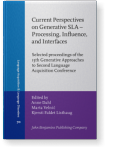Chapter 9
Sensitivity to silently structured interveners
Sluicing interpretation in L2 learners
One of the central issues in generative approaches to second language acquisition is whether second language (L2) learners can use syntactic manipulation in the L2, as they do in the first language (L1). To explore this issue, this study investigates sensitivity to intervention effects in sluicing structures, specifically, the asymmetry between object and subject extraction. The results of a picture-sentence judgment task indicate that L1-Japanese/L2-English learners with relatively low proficiency exhibit sensitivity to the intervention effect, showing greater difficulty in the case of object extraction in both non-sluicing and sluicing structures. Consequently, this study suggests that even learners with low L2 proficiency can achieve deep syntactic manipulations, including building up an elided structure and moving the wh-element from it.
Article outline
- 1.Introduction
- 2.Background
- 2.1Syntax of sluicing in English and Japanese
- 2.2Theoretical approaches to the structure of sluicing
- 2.3Acquisition of sluicing
- 2.4Theoretical accounts of the intervention effect
- 2.5Relative difficulty of sentences with intervening elements
- 3.The study
- 3.1Participants
- 3.2Methods
- 3.3Data analysis
- 4.Results
- 5.Discussion
- 6.Conclusion
-
Acknowledgements
-
Notes
-
References
This content is being prepared for publication; it may be subject to changes.
